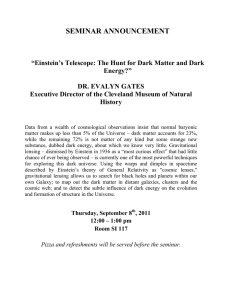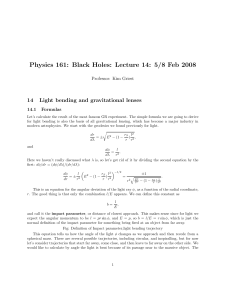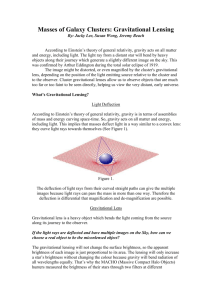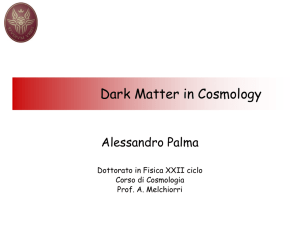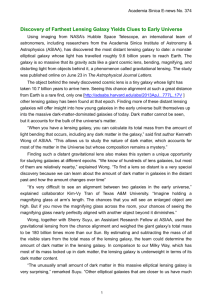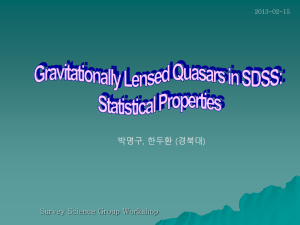Gravitational Lensing Diana Streng Phy 495
advertisement
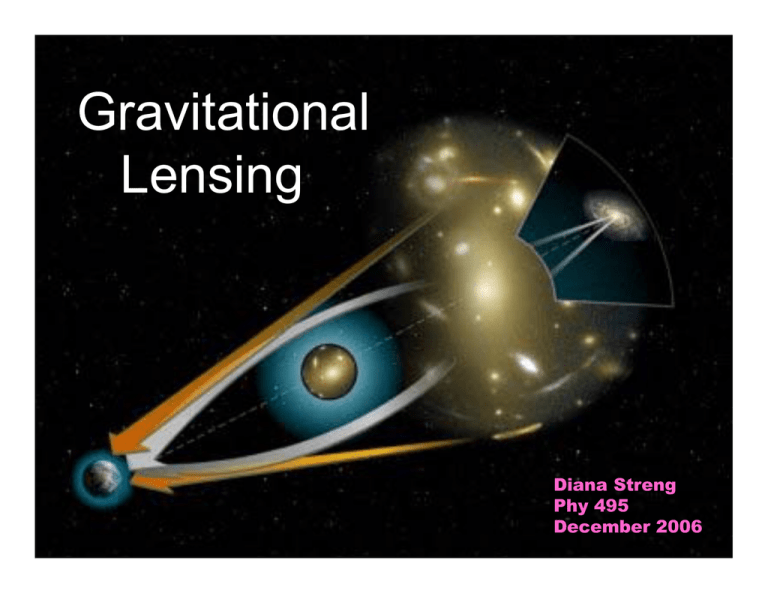
Gravitational Lensing Diana Streng Phy 495 December 2006 Topics Light deflection, and how spacetime curvature dictates gravitational lensing (GL) A brief history about the GL phenomenon Types of GL Effects Applications Preliminary Notes ¾ 1 parsec = “the distance from the Earth to a star that has a parallax of 1 arcsecond” = 3.08567758×1016 m = 3.26156378 light years Preliminary Notes 1 Arcminute = (1/60) of 1 degree Æ 1’ 1 Arcsecond = (1/60) of 1 arcminute Æ 1” = (1/3600) of 1 degree Hubble’s Law Redshift v = H 0d λobs − λemit z= λemit where H0 = 70 km/s/Mpc v 1+ c = v 1− c Gravitational Lensing Gravitational Lensing A product of Einstein’s general theory of relativity, but first predicted by A. Einstein in 1912 Occurs in any accelerated frame of reference. Details governed by spacetime curvature. Early thoughts on Gravitational Lensing… “Of course there is not hope in observing this phenomenon directly. First, we shall scarcely ever approach closely enough to such a central line. Second, the angle beta will defy the resolving power of our instruments.” -- Albert Einstein, in his letter to Science magazine, 1936 Timeline 1919 – Arthur Eddington – multiple images may occur during a solar eclipse. 1936 – R.W. Mandl wrote Einstein on the possibility of G.L. by single stars. Einstein published discussion in Science magazine, volume 84, No. 2188, December 4, 1936, pg. 506-507 1937 – Fritz Zwicky considered G.L. by galaxies and calculated Deflection angles Image strengths (Timeline) 1963 – Realistic scenarios for using G.L. Quasi-stellar objects Distant galaxies Determining distances and masses in lensing systems. 1979 – Walsh, Carswell, and Weymann detect first G.L. at Kitt Peak National Observer, 2.1 meter telescope Q0957+561 (Nature, pgs. 279-281). Observers begin noting these systems with optical telescopes 1983 – First International Conference on Lensing. Q0957+561 Constellation Ursa Major Q0957+561 A double imaged quasar: Q0957+561 A and Q0957+561 B Lies at redshift z = 1.41 (98 billion LY), while lensing galaxy lies at z = 0.355 (7.8 billion LY) The lensing galaxy lies 1 arcsecond off line of B image. Q0957+561 Images A and B are separated by 6” Lensing Galaxy: G1 (Giant Elliptical) ⎡ z ⎤ 1 t=⎢ ⎥ ⎣ z + 1⎦ H 0 A and B have apparent magnitude of 17 Aabsolute = 16.5, Babsolute= 16.0 1.4 year time lag between A and B ⎡ z ⎤ 1 t=⎢ ⎥H z 1 + ⎦ 0 ⎣ Hubble’s Constant = 70km/s/Mpc Light Deflection All material bodies deflect light trajectories. The deflection angle is a property of the shape of the orbit of a light ray. The shape of a light ray orbit can be calculated the same as for a particle orbit dφ 1 =± 2 dr r ⎡ 1 1 ⎛ 2M ⎢ b 2 − r 2 ⎜1 − r ⎝ ⎣ ⎞⎤ ⎟⎥ ⎠⎦ −1 / 2 In c = 1 units Light Deflection The magnitude of the total angle swept out is twice the angle swept out from the turning point to infinity: −1 / 2 dr ⎡ 1 1 ⎛ 2M ∆φ = 2 ∫ 2 ⎢ 2 − 2 ⎜1 − r1 r r r ⎝ ⎣b ∞ ⎞⎤ ⎟⎥ ⎠⎦ Image Distortion 2006 Multiple Images Quadruply Lensed Quasar with Einstein Ring • July 18, 2003 • ESO 3.6-m telescope, La Silla (Chile) • Southern constellation Crater • Nearest gravitationally lensed quasar to date • Quasar, z = 0.66 (6.3 billion LY) • Lensing Body: Massive Elliptical Galaxy, z = 0.3 (3.5 billion LY) Schwarzschild Metric Describes the gravitational field outside a spherical non-rotating mass, and good approx. for a slowly rotating mass (Earth, Sun) −1 2GM ⎤ 2 ⎡ 2GM ⎤ 2 2⎡ ds = −c ⎢1 − 2 ⎥ (dt ) + ⎢1 − 2 ⎥ (dr 2 ) + r 2 dΩ 2 c r ⎦ c r ⎦ ⎣ ⎣ dΩ 2 = dθ 2 + sin 2 θdφ 2 Schwarzschild Radius: Standard line element of 2-sphere (i.e. globe) 2GM rS = c2 the radius for a given mass where, if that mass could be compressed to fit within that radius, no force could stop it from continuing to collapse into a gravitational singularity. Schwarzschild Metric Light rays travel on null geodesics (ds2 = 0) Stable Circular Orbit: r > 3rS Unstable Circular Orbit: (3rS/2) < r < 3rS No Circular Orbits: r < (3rS/2) WHY should astronomers look for Gravitational Lenses? Testing General Relativity Determining Nebular Masses Extends measurement of Magnitudes Three Types of Gravitational Lensing Strong Lensing Weak Lensing Microlensing 1. Strong Lensing 9 Easily visible distortions 9 May produce image separations of several arcminutes (i.e.) A galaxy with mass over 100 billion solar masses will produce multiple images separated by only a few arcseconds 9 Also observed in X-rays and radio waves Strong Lensing Effects • Einstein Rings/Arcs (aka Chowlson Ring) ¾ a deformation of the light from a source into a ring through gravitational deflection of the source’s light by a lens ¾ Occurs when the source, lens and observer are all aligned ¾ We see an arc when the object, lens, and observer are not perfectly aligned. ¾ Observed for distant galaxies. Strong Lensing Applications Strong GL are used to examine objects at distances at which they would normally not be visible This provides information from further back in time than otherwise possible. Inverting the lens equations, we can find out the mass and distribution of the lensing body 2. Weak Lensing 9 Occurs near large scale structures, i.e. galaxy clusters 9 Distortions of background objects much smaller; 9 Detected by analyzing large numbers of objects (to find distortion of a few percent) 9 Effects are being studied for the Cosmic Background and Galaxy surveys Weak Lensing Effects Weak Lensing The lens galaxies (yellowish) deflect the light from the distant quasar (blueish), producing 4 images If brightness varies with time, we can measure the expansion rate of the universe Positions of the four images give information about the mass of the lens Applications – Dark Matter The most important application in cosmology is weak lensing of galaxies Measuring shapes and orientations of many distant galaxies, we can measure the shear of the lensing field We can then reconstruct the background mass distribution of the area Also, calculate the amount of DM contained in the lensing body 3. Microlensing 9 Produced by a mass of about 1 star 9 Source and lens must be closely aligned 9 Movement of object Æ Change in distortion Æ Speed of the object 9 Amount of light received from background object changes in time, no shape distortions 9 Both the background source and the lens are in the Milky Way Galaxy 9 Chances of this happening are about one in a million (it took 57 years from the time the effect was predicted to its observational confirmation) Microlensing Effects Brightening of a star May occur in our own solar system (i.e. sunlight) When the star and its orbiting planet are in a line to the observer, gravity causes a temporary increase in the apparent brightness of the star This method can detect objects that do not emit light Applications Can provide information on comparatively small astronomical objects like MACHO’s and extrasolar planets These masses range from (1/100)’s Æ 100’s of solar masses. These objects are dark and hard to find 3 planets have been found Can find earth-sized planets around sun-like stars within the 21 century. Avoiding Error Surveys must be careful to avoid sources of systematic error: Intrinsic elliptical shape of galaxies : shape of galaxies EveryIntrinsic galaxyelliptical has a particular unknown shape – so how can we measure the distortion of the image? Æ Ellipticities of the distorted galaxies are measured and averaged out. “Atmospheric Seeing” – “twinkling” Camera: Point Spread Function, distorts galaxies Future Applications – The Cosmological Constant GL statistics can be used to measure values such as the Cosmo Constant and the mean density of matter in the universe. Presently, the statistics don’t provide very strong limits on these parameters because we have not found enough strong lenses. (There are < 100) Summary 9 Gravitational lensing, a property of general relativity, is proven by the existence of “Einstein Rings” 9 Strong, Weak, and Microlensing 9 Yields valuable information about the earth – lens – object system 9 Applications: seeing things further in past, determining cosmological constants (i.e. H0), finding mass distribution Æ Dark Matter? THE END Thanks for Coming! Works Cited • • • • • • • • • • • • • • • • • • • • • Hartle, James B. Relativity. Addison Wesley, San Francisco, CA, 2003. Weak Lensing Material http://images.google.com/imgres?imgurl=http://www.cita.utoronto.ca/~hoekstra/einstein_cross.jpg&imgre furl=http://www.cita.utoronto.ca/~hoekstra/lensing.html&h=465&w=800&sz=43&hl=en&start=2&tbnid=1lc7 Hq_oK1xq_M:&tbnh=83&tbnw=143&prev=/images%3Fq%3Dweak%2Blensing%26svnum%3D10%26hl%3D en%26lr%3D%26sa%3DN Wikipedia – Gravitational Lensing http://en.wikipedia.org/wiki/Gravitational_lensing Cover Picture http://www.space.com/images/h_hubble_lens_03a.jpg Abell 2218 photo http://antwrp.gsfc.nasa.gov/apod/image/0110/a2218c_hst_big.jpg Einstein Ring photo http://cfa-www.harvard.edu/ep/whatsnew/ring-sml.jpg Multiple Images Picture http://universe.nasa.gov/press/images/EinsteinRings/EinsteinRing_schematic.gif Weak Lensing http://images.google.com/imgres?imgurl=http://www.ast.cam.ac.uk/~ljw/ioa_new/images/weaklens_small. gif&imgrefurl=http://www.ast.cam.ac.uk/~ljw/ioa_new/Research/Grav_Lens/&h=175&w=176&sz=17&hl=en &start=25&tbnid=k5KvjL6M5MJlUM:&tbnh=99&tbnw=100&prev=/images%3Fq%3Dweak%2Blensing%26sta rt%3D20%26ndsp%3D20%26svnum%3D10%26hl%3Den%26lr%3D%26sa%3DN Z Calculation Applet http://hyperphysics.phy-astr.gsu.edu/Hbase/astro/redshf.html#c2 Red Shift http://hyperphysics.phy-astr.gsu.edu/Hbase/astro/redshf.html#c1 Hubble’s Constant Applet http://hyperphysics.phy-astr.gsu.edu/hbase/astro/hubble.html#c3
